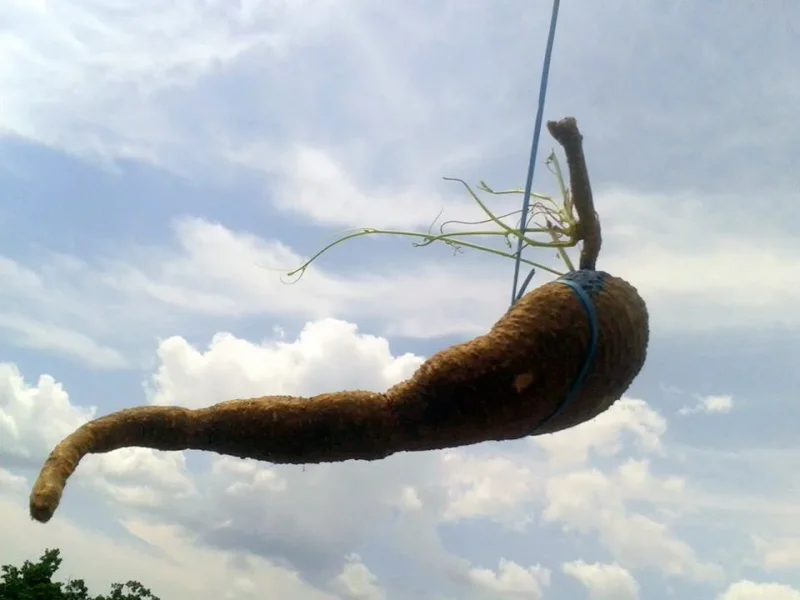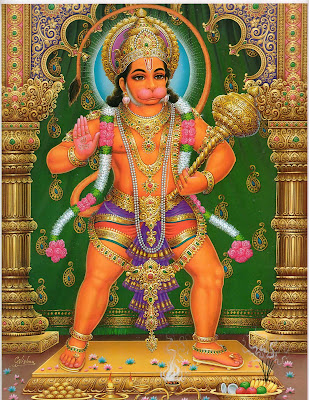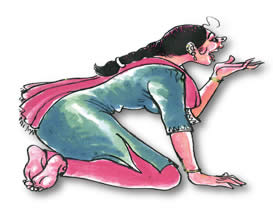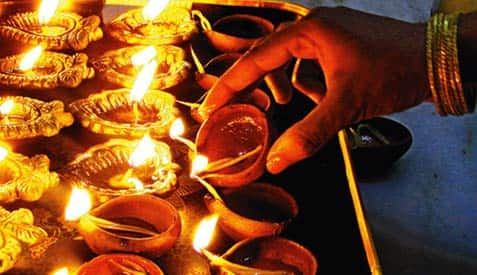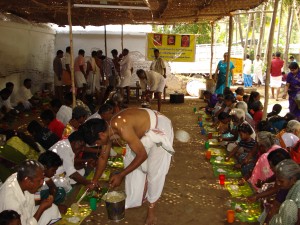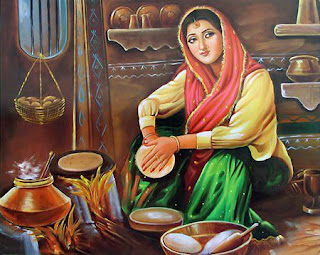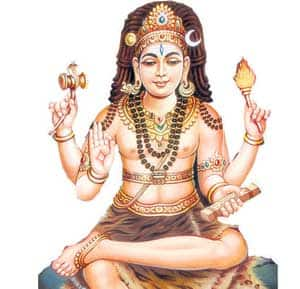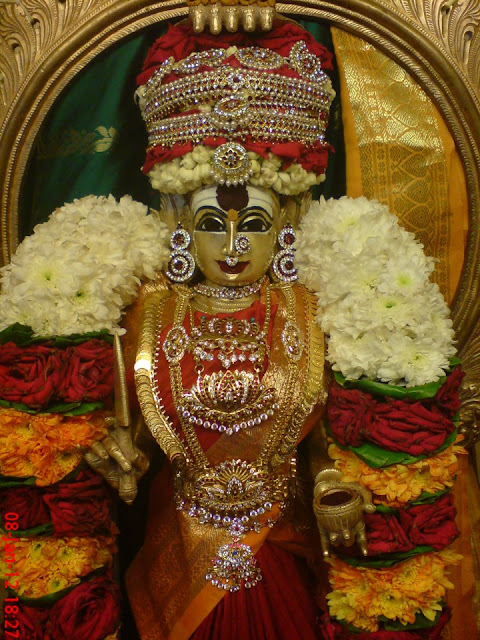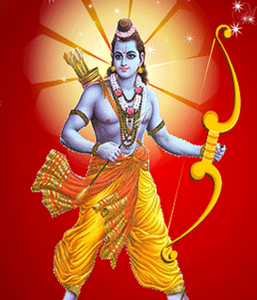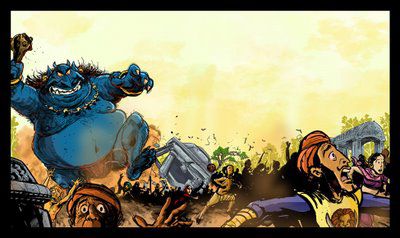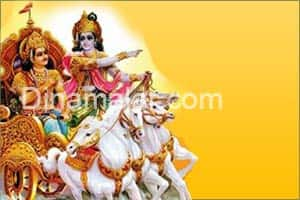P.J.
0
கும்பாபிஷேகம் : சில தகவல்கள் ...
கும்பாபிஷேகம் : சில தகவல்கள் ...
அக்டோபர் 21,2010

கும்பாபிஷேகத்தின் போது என்னென்ன சடங்குகள் நடத்தப்படும் என்பதை பார்த்திருப்பீர்கள். அவற்றிற்குரிய விளக்கத்தை தெரிந்து கொள்ளுங்கள்.
ஆவாஹனம்
ஆவாஹனம் என்றால் கும்பத்தில் உள்ள நீருக்குள் மூர்த்திகளை எழுந்தருள செய்தல் என்பது பொருள். கும்பத்தை முதலில் கோயிலில் உள்ள தெய்வத்திருவின் அருகில் வைத்து தர்ப்பை, மாவிலை ஆகியவற்றைக் கொண்டு மந்திரங்கள் ஓதி, பிம்பத்தில் விளங்கும் மூர்த்தியை கும்பத்தில் எழுந்தருளச் செய்வார்கள். பிறகு அந்த கும்பத்தை யாகசாலைக்கு எழுந்தருளச் செய்வார்கள். தர்ப்பையின் மூலம் கும்பத்தில் உள்ள தெய்வீக சக்தியை பிம்பத்திற்கு மீண்டும் செலுத்துவார்கள்.
கும்பம்
யாகசாலையில் மந்திரம், கிரியை, தியானம் ஆகியவற்றுடன் வளர்க்கப்பட்டு எழும் புகையுடன் வேத ஒலி, சிவாகம ஒலி, மறை ஒலி ஆகியவற்றுடன் பக்தர்களின் நல்ல எண்ணங்களும், எங்கும் நிறைந்திருக்கின்ற திருவருள் சக்தியை தூண்டிவிட்டு கும்பத்தில் விளங்கச் செய்யும். அப்போது கும்பம் தெய்வீக சக்தி பெறும். இந்த கும்பத்தை சிவனின் வடிவமாக ஆகமங்கள் கூறுகின்றன.
பாலாலயம்
கும்பத்தை கோயிலில் உள்ள தெய்வச்சிலை அருகில் வைப்பார்கள். தர்ப்பை, மாவிலை கொண்டு மந்திரங்கள் ஓதி, தெய்வ வடிவில் விளங்கும் மூர்த்தியை கும்பத்திற்கு மாற்றுவார்கள். பின்பு அதை வேறிடத்திற்கு எழுந்தருளச் செய்வார்கள். இதை பாலாலய பிரவேசம் என்பர்.
கிரியைகள்
கும்பாபிஷேகம் நடக்கும்போது ஒரு காலத்தில் 64 கிரியைகள் செய்யப்பட்டன. காலப்போக்கில் 55 கிரியைகள் செய்யப்பட்டன. ஆனால் தற்போது எல்லா கிரியைகளும் செய்யப்படுவதில்லை. 64ல் முக்கியமான 13 கிரியைகளை மட்டும் தேர்ந்தெடுத்து கும்பாபிஷேகத்தை நடத்துகின்றனர்.
ஆசாரியவர்ணம்
கும்பாபிஷேகத்திற்கென கிடைக்கும் பொருளுக்கு பூஜை செய்ய வேண்டும். இதை தன பூஜை என்பர். பூஜை செய்த பணம் அல்லது பொருளில் ஒரு பகுதியை கட்டட வேலைக்கும், ஒரு பகுதியை நித்திய, மாதாந்திர, விசேஷ நட்சத்திர பூஜை உற்சவத்திற்கும், மூன்றாவது பாகத்தை ஆபரணங்கள் வாங்கவும் ஒதுக்குவார்கள். இப்படியே கோயில் காரியங்கள் சம்பந்தப்பட்ட 11 பாகமாக இந்த செல்வத்தை பிரிப்பார்கள். கும்பாபிஷேகத்தை நடத்தும் பிரதான ஆசாரியரை வணங்கி, இந்த செல்வத்தைக் கொண்டு குடமுழுக்கு நடத்தி தாருங்கள் என கேட்டுக்கொள்ள வேண்டும். இதையே ஆசாரியவர்ணம் என்பர்.
அனுக்ஞை
கோயில் பழுது பார்க்கப்பட்டு திருப்பணிகள் நிறைவு பெற்ற பிறகு, ஒரு நல்ல நாளில் கும்பாபிஷேக நிகழ்ச்சியை முன்னின்று நடத்தி வைப்பதற்கு தகுதியான ஒருவரை தேர்ந்தெடுப்பதையே அனுக்ஞை என்கிறார்கள். விநாயகர் சன்னதி முன்பு இந்த நிகழ்ச்சி நடக்கும். சம்பந்தப்பட்டவரே கும்பாபிஷேகத்தை நடத்தித் தர அனுமதி தரவேண்டும் என விநாயகரிடம் வேண்டி கேட்டுக்கொள்வதே அனுக்ஞை ஆகும்.
பிரவேசபலி
கும்பாபிஷேகம் செய்யும் இடத்திலிருந்து எட்டு திசைகளிலும் வசிக்கின்ற ராட்சதர் முதலான தேவதைகளுக்கு உணவு கொடுத்து எழுப்பி, அவர்களை கடல், மலை, காடு, ஆறு, மயானம் ஆகிய இடங்களில் சென்று இருங்கள் என திருப்திப்படுத்தி வழி அனுப்புவதே பிரவேச பலி ஆகும். கும்பாபிஷேகங்களில் மட்டுமின்றி, கோயில்களில் திருவிழா நடக்கும்போதுகூட இதை செய்ய வேண்டுமென்று ஆகமங்கள் கூறுகின்றன.
வாஸ்துசாந்தி
ஆகமங்களிலும், சிவமகா புராணத்திலும் வாஸ்து பற்றி கூறப்பட்டுள்ளது. அந்தகாசுரன் என்பவனை கொல்வதற்காக தேவர்கள் சிவபெருமானிடம் கோரிக்கை வைத்தனர். சிவபெருமான் தனது வியர்வைத் துளியிலிருந்து ஒரு பூதத்தை உருவாக்கி அந்தகாசுரனை வதைத்தார். அந்த பூதம் சிவனிடம் பல வரங்கள் பெற்று உலகத்தை வருத்தியது. சிவபெருமான் பூதத்தை அடக்க அதிபவன் என்பவரை சிருஷ்டித்து அனுப்பினார். அதிபவன் அந்த பூதத்தின் உடலின்மீது 53 தேவதைகளை வசிக்க செய்து, மாயக்கயிறுகளால் கட்டினார். இதனால் இவர் வாஸ்துபுருஷன் என பெயர் பெற்றார். வாஸ்து புருஷனால் குடமுழுக்கு கிரியைக்கு இடையூறு நேராதபடி 53 தேவதைகளுக்கும் பூஜை, பலி, ஹோமம் ஆகியவற்றால் சாந்தி செய்ய வேண்டும். இதுவே வாஸ்துசாந்தி ஆகும்.
ரக்ஷா பந்தன்
காப்பு கட்டுதல் என இதற்கு பொருள். சிவாச்சாரியார்கள் நாகராஜனுக்கு பூஜை செய்து, மந்திரித்த மஞ்சள்கயிறை வலது மணிக்கட்டில் கட்டிக்கொள்வார்கள். கும்பாபிஷேகத்தில் கலந்துகொள்ளும் சிவாச்சாரியார்களின் குடும்பத்தில் எதிர்பாராதவகையில் ஏதாவது தீட்டு ஏற்பட்டால் காப்பு அவிழ்க்கப்படும்வரை அந்த தீட்டு அவர்களை பாதிக்காது.
கடஸ்தாபனம்
கும்பாபிஷேகத்தில் மிக முக்கியமானது கடஸ்தாபனம். கலசம் நிறுவுதல் என்பது இதன் பொருள். தங்கம், வெள்ளி, தாமிரம், மண் ஆகிய ஏதாவது ஒன்றில் கும்பங்கள் செய்யப்படும். கும்பங்களை இப்படித்தான் அமைக்க வேண்டும் என்ற வரையறைகள் உள்ளன. இவ்வாறு அமைக்கப்பட்ட கும்பங்களை குறைகள் இல்லாமல் மந்திரித்து, அக்னியில் காட்டுவார்கள். சிவப்பு மண்ணை கும்பத்தின் மீது பூசி, நூல் சுற்றி ஆற்றுநீர் அல்லது ஊற்று நீரால் நிரப்புவார்கள். கும்பத்தின் மேல் வாய் பகுதியில் மாவிலைகளை செருகி, தேங்காய் வைப்பார்கள். கும்பத்திற்குள் நவரத்தினம், தங்கம், வெள்ளி, நவதானியம் ஆகியவற்றை பரப்புவார்கள். எந்த மூர்த்திக்கு குடமுழுக்கு நடக்கிறதோ அந்த மூர்த்தியின் உடலாக அந்த கும்பம் கருதப்படும்.
அஷ்டபந்தனம்
கும்பாபிஷேகத்தை அஷ்டபந்தன மகா கும்பாபிஷேகம் என சொல்வதுண்டு. பீடத்தின்மீது வைக்கப்படும் தெய்வ திருவுருவங்கள் அசையாமல் உறுதியுடன் நிலைத்து நிற்க, கொம்பரக்கு, சுக்கான்தான், குங்குலியம், கற்காவி, செம்பஞ்சு, ஜாதிலிங்கம், தேன்மெழுகு, எருமையின் வெண்ணெய் ஆகிய எட்டுவகை மருந்துகளை கலந்து சார்த்துவார்கள். அஷ்டம் என்றால் எட்டு என பொருள். இந்த எட்டுவகை மருந்துகளை சார்த்துவதற்கே அஷ்ட பந்தனம் என பெயர்.
மிகுத்சம்கிரஹணம்
இதற்கு மண் எடுத்தல் என பொருள். கும்பாபிஷேகத்தின்போது அங்குரார்ப்பணம் எனப்படும் முளையிடுதல் நிகழ்ச்சி நடக்கும். மண்ணைத்தோண்டி பாலிகைகளில் இட்டு, நவதானியங்களை தெளித்து, முளைப்பாலிகை அமைப்பார்கள். இதுவே மிகுத்சம் கிரகஹணம் எனப்படும்.
http://temple.dinamalar.com/news_detail.php?id=521
கும்பாபிஷேகம் : சில தகவல்கள் ...
அக்டோபர் 21,2010

கும்பாபிஷேகத்தின் போது என்னென்ன சடங்குகள் நடத்தப்படும் என்பதை பார்த்திருப்பீர்கள். அவற்றிற்குரிய விளக்கத்தை தெரிந்து கொள்ளுங்கள்.
ஆவாஹனம்
ஆவாஹனம் என்றால் கும்பத்தில் உள்ள நீருக்குள் மூர்த்திகளை எழுந்தருள செய்தல் என்பது பொருள். கும்பத்தை முதலில் கோயிலில் உள்ள தெய்வத்திருவின் அருகில் வைத்து தர்ப்பை, மாவிலை ஆகியவற்றைக் கொண்டு மந்திரங்கள் ஓதி, பிம்பத்தில் விளங்கும் மூர்த்தியை கும்பத்தில் எழுந்தருளச் செய்வார்கள். பிறகு அந்த கும்பத்தை யாகசாலைக்கு எழுந்தருளச் செய்வார்கள். தர்ப்பையின் மூலம் கும்பத்தில் உள்ள தெய்வீக சக்தியை பிம்பத்திற்கு மீண்டும் செலுத்துவார்கள்.
கும்பம்
யாகசாலையில் மந்திரம், கிரியை, தியானம் ஆகியவற்றுடன் வளர்க்கப்பட்டு எழும் புகையுடன் வேத ஒலி, சிவாகம ஒலி, மறை ஒலி ஆகியவற்றுடன் பக்தர்களின் நல்ல எண்ணங்களும், எங்கும் நிறைந்திருக்கின்ற திருவருள் சக்தியை தூண்டிவிட்டு கும்பத்தில் விளங்கச் செய்யும். அப்போது கும்பம் தெய்வீக சக்தி பெறும். இந்த கும்பத்தை சிவனின் வடிவமாக ஆகமங்கள் கூறுகின்றன.
பாலாலயம்
கும்பத்தை கோயிலில் உள்ள தெய்வச்சிலை அருகில் வைப்பார்கள். தர்ப்பை, மாவிலை கொண்டு மந்திரங்கள் ஓதி, தெய்வ வடிவில் விளங்கும் மூர்த்தியை கும்பத்திற்கு மாற்றுவார்கள். பின்பு அதை வேறிடத்திற்கு எழுந்தருளச் செய்வார்கள். இதை பாலாலய பிரவேசம் என்பர்.
கிரியைகள்
கும்பாபிஷேகம் நடக்கும்போது ஒரு காலத்தில் 64 கிரியைகள் செய்யப்பட்டன. காலப்போக்கில் 55 கிரியைகள் செய்யப்பட்டன. ஆனால் தற்போது எல்லா கிரியைகளும் செய்யப்படுவதில்லை. 64ல் முக்கியமான 13 கிரியைகளை மட்டும் தேர்ந்தெடுத்து கும்பாபிஷேகத்தை நடத்துகின்றனர்.
ஆசாரியவர்ணம்
கும்பாபிஷேகத்திற்கென கிடைக்கும் பொருளுக்கு பூஜை செய்ய வேண்டும். இதை தன பூஜை என்பர். பூஜை செய்த பணம் அல்லது பொருளில் ஒரு பகுதியை கட்டட வேலைக்கும், ஒரு பகுதியை நித்திய, மாதாந்திர, விசேஷ நட்சத்திர பூஜை உற்சவத்திற்கும், மூன்றாவது பாகத்தை ஆபரணங்கள் வாங்கவும் ஒதுக்குவார்கள். இப்படியே கோயில் காரியங்கள் சம்பந்தப்பட்ட 11 பாகமாக இந்த செல்வத்தை பிரிப்பார்கள். கும்பாபிஷேகத்தை நடத்தும் பிரதான ஆசாரியரை வணங்கி, இந்த செல்வத்தைக் கொண்டு குடமுழுக்கு நடத்தி தாருங்கள் என கேட்டுக்கொள்ள வேண்டும். இதையே ஆசாரியவர்ணம் என்பர்.
அனுக்ஞை
கோயில் பழுது பார்க்கப்பட்டு திருப்பணிகள் நிறைவு பெற்ற பிறகு, ஒரு நல்ல நாளில் கும்பாபிஷேக நிகழ்ச்சியை முன்னின்று நடத்தி வைப்பதற்கு தகுதியான ஒருவரை தேர்ந்தெடுப்பதையே அனுக்ஞை என்கிறார்கள். விநாயகர் சன்னதி முன்பு இந்த நிகழ்ச்சி நடக்கும். சம்பந்தப்பட்டவரே கும்பாபிஷேகத்தை நடத்தித் தர அனுமதி தரவேண்டும் என விநாயகரிடம் வேண்டி கேட்டுக்கொள்வதே அனுக்ஞை ஆகும்.
பிரவேசபலி
கும்பாபிஷேகம் செய்யும் இடத்திலிருந்து எட்டு திசைகளிலும் வசிக்கின்ற ராட்சதர் முதலான தேவதைகளுக்கு உணவு கொடுத்து எழுப்பி, அவர்களை கடல், மலை, காடு, ஆறு, மயானம் ஆகிய இடங்களில் சென்று இருங்கள் என திருப்திப்படுத்தி வழி அனுப்புவதே பிரவேச பலி ஆகும். கும்பாபிஷேகங்களில் மட்டுமின்றி, கோயில்களில் திருவிழா நடக்கும்போதுகூட இதை செய்ய வேண்டுமென்று ஆகமங்கள் கூறுகின்றன.
வாஸ்துசாந்தி
ஆகமங்களிலும், சிவமகா புராணத்திலும் வாஸ்து பற்றி கூறப்பட்டுள்ளது. அந்தகாசுரன் என்பவனை கொல்வதற்காக தேவர்கள் சிவபெருமானிடம் கோரிக்கை வைத்தனர். சிவபெருமான் தனது வியர்வைத் துளியிலிருந்து ஒரு பூதத்தை உருவாக்கி அந்தகாசுரனை வதைத்தார். அந்த பூதம் சிவனிடம் பல வரங்கள் பெற்று உலகத்தை வருத்தியது. சிவபெருமான் பூதத்தை அடக்க அதிபவன் என்பவரை சிருஷ்டித்து அனுப்பினார். அதிபவன் அந்த பூதத்தின் உடலின்மீது 53 தேவதைகளை வசிக்க செய்து, மாயக்கயிறுகளால் கட்டினார். இதனால் இவர் வாஸ்துபுருஷன் என பெயர் பெற்றார். வாஸ்து புருஷனால் குடமுழுக்கு கிரியைக்கு இடையூறு நேராதபடி 53 தேவதைகளுக்கும் பூஜை, பலி, ஹோமம் ஆகியவற்றால் சாந்தி செய்ய வேண்டும். இதுவே வாஸ்துசாந்தி ஆகும்.
ரக்ஷா பந்தன்
காப்பு கட்டுதல் என இதற்கு பொருள். சிவாச்சாரியார்கள் நாகராஜனுக்கு பூஜை செய்து, மந்திரித்த மஞ்சள்கயிறை வலது மணிக்கட்டில் கட்டிக்கொள்வார்கள். கும்பாபிஷேகத்தில் கலந்துகொள்ளும் சிவாச்சாரியார்களின் குடும்பத்தில் எதிர்பாராதவகையில் ஏதாவது தீட்டு ஏற்பட்டால் காப்பு அவிழ்க்கப்படும்வரை அந்த தீட்டு அவர்களை பாதிக்காது.
கடஸ்தாபனம்
கும்பாபிஷேகத்தில் மிக முக்கியமானது கடஸ்தாபனம். கலசம் நிறுவுதல் என்பது இதன் பொருள். தங்கம், வெள்ளி, தாமிரம், மண் ஆகிய ஏதாவது ஒன்றில் கும்பங்கள் செய்யப்படும். கும்பங்களை இப்படித்தான் அமைக்க வேண்டும் என்ற வரையறைகள் உள்ளன. இவ்வாறு அமைக்கப்பட்ட கும்பங்களை குறைகள் இல்லாமல் மந்திரித்து, அக்னியில் காட்டுவார்கள். சிவப்பு மண்ணை கும்பத்தின் மீது பூசி, நூல் சுற்றி ஆற்றுநீர் அல்லது ஊற்று நீரால் நிரப்புவார்கள். கும்பத்தின் மேல் வாய் பகுதியில் மாவிலைகளை செருகி, தேங்காய் வைப்பார்கள். கும்பத்திற்குள் நவரத்தினம், தங்கம், வெள்ளி, நவதானியம் ஆகியவற்றை பரப்புவார்கள். எந்த மூர்த்திக்கு குடமுழுக்கு நடக்கிறதோ அந்த மூர்த்தியின் உடலாக அந்த கும்பம் கருதப்படும்.
அஷ்டபந்தனம்
கும்பாபிஷேகத்தை அஷ்டபந்தன மகா கும்பாபிஷேகம் என சொல்வதுண்டு. பீடத்தின்மீது வைக்கப்படும் தெய்வ திருவுருவங்கள் அசையாமல் உறுதியுடன் நிலைத்து நிற்க, கொம்பரக்கு, சுக்கான்தான், குங்குலியம், கற்காவி, செம்பஞ்சு, ஜாதிலிங்கம், தேன்மெழுகு, எருமையின் வெண்ணெய் ஆகிய எட்டுவகை மருந்துகளை கலந்து சார்த்துவார்கள். அஷ்டம் என்றால் எட்டு என பொருள். இந்த எட்டுவகை மருந்துகளை சார்த்துவதற்கே அஷ்ட பந்தனம் என பெயர்.
மிகுத்சம்கிரஹணம்
இதற்கு மண் எடுத்தல் என பொருள். கும்பாபிஷேகத்தின்போது அங்குரார்ப்பணம் எனப்படும் முளையிடுதல் நிகழ்ச்சி நடக்கும். மண்ணைத்தோண்டி பாலிகைகளில் இட்டு, நவதானியங்களை தெளித்து, முளைப்பாலிகை அமைப்பார்கள். இதுவே மிகுத்சம் கிரகஹணம் எனப்படும்.
http://temple.dinamalar.com/news_detail.php?id=521

